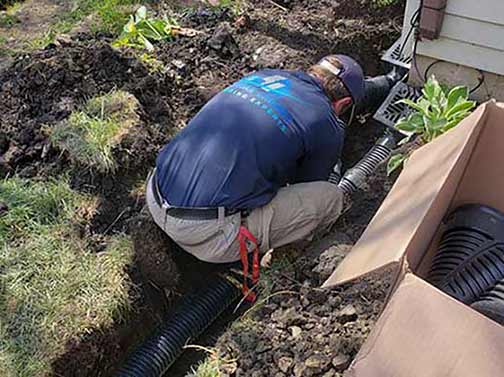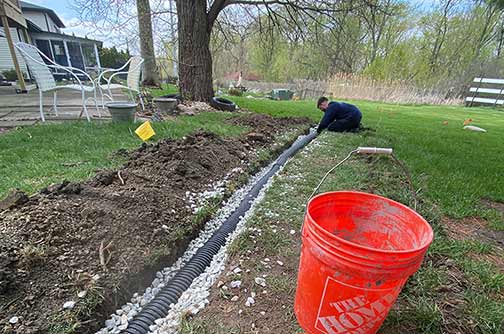Understanding the Basics of French Drains and Why They are Important in Residential Drainage Systems
French drains are a basic element in the realm of residential drainage systems in terms of a means to manage standing water around a house. Their significance cannot be overstated, especially where heavy rain, snow, or poorly draining soil leads to water standing that is a threat to the structural integrity of a dwelling. Proper water control is required to prevent basement flooding, foundation cracking, soil erosion, and landscape damage, all of which can lead to costly repairs and decreased property value.
Homeowners should have a solid grasp of French drains fundamentals as a basis for the protection of their homes and enhancement of outdoor settings. Below we aim to demystify the process, describe the basic components, and provide hands-on installation tips, troubleshooting, and maintenance instructions in an easy-to-read, friendly format for a multicultural audience.
The Basic Principle of a French Drain: How it Works to Regulate Water Flow
A French drain is literally a trench filled with crushed stone or gravel that acts to permit the flow of water away from locations where it could cause damage. Basically, the system consists of a perforated pipe that runs through the trench, acting as a conduit for water to flow in and be diverted to a drainage area. When rain falls or snow melts, water tends to follow the path of least resistance, draining into the gravel trench. The perforated pipe, laid along this bed of gravel, absorbs the water and directs it away from areas of vulnerability like a house foundation, basement, or garden beds.
The entire system is gravity-fed, relying on a gentle slope downward to allow for continuous flow of water to the discharge point, which can be a storm drain, dry well, or other safe location of discharge. This efficient yet simple system does not allow for accumulation of water, thus eliminating extreme structural and landscaping issues. The system utilizes natural water flow and gravity, making it low maintenance and inexpensive for homeowners looking to increase drainage on their property.
Key Components of a French Drain System: Pillars of Effective Water Flow
A French drain’s success and longevity are determined by its well-planned components, which play a contributing role in ensuring maximum water flow and filtering. The foundation of the system is the trench, which must be excavated to an appropriate width and depth—typically 6 inches wide by 18 to 24 inches deep—based on how much water is expected and what the terrain is like. The perforated pipe, typically made of robust PVC or corrugated plastic, is installed within the trench, following the natural grade to provide gravity-fed flow. A gravel or crushed stone circular bed encloses the pipe, which acts as a filter and provides adequate surface area for water to collect and move freely.
A geotextile fabric or landscape fabric, to prevent the system from being clogged by dirt and soil, encloses the gravel and the pipe. It’s a screen that permits water to pass through while not larger-sized matter. The final step is to top the trench with grass or soil, creating the natural appearance of the landscape while protecting the inner components from damage. All components of the system are important in order for it to function properly in diverting water from delicate areas and remaining operational for decades to come.
Planning and Designing Your French Drain: Important Things to Consider Prior to Installation
A French drain relies on proper planning and meticulous design for it to be effective. Homeowners must begin by taking a good look at their home to determine where water accumulates, such as in low spots, slopes, or near the foundation. A site analysis reveals those areas where the drain will work best. As important as knowing the topography of the land and where water will flow, and where the drain should be placed to function optimally. Special attention should be paid in deciding where to place the discharge point so that it does not divert water onto adjacent properties or cause new drainage problems elsewhere.
During the planning phase, one has to consider the depth and width of the trench, the type of soil—be it sand, loam, or clay—and how much water the system will have to handle, especially during storms. Consultation with drainage specialists or landscape architects can be helpful since they would ensure that the plan accommodates your specific landscape and drainage needs. Adequate planning not only enhances the efficiency of the system but also prevents costly on-site adjustments.

Step-by-Step Installation of a French Drain: Excavation to Covering
Installation of a French drain requires step-by-step implementation, so ideal planning goes hand in hand with precise execution. Marking out the trench route represents the starting point. It needs the right slope, typically at least 1% fall, in order to permit gravity-driven flow of water. The use of stakes and string lines may be used to secure an even slope throughout the trench. Next, excavate the trench to desired dimensions, typically 6 inches in width and 18 to 24 inches deep, depending on the amount of water and ground topography.
Once excavation of the trench is complete, use landscape fabric to line it, extending it beyond the edges to prevent invading soil. Set the perforated pipe in the trench, sloping as directed and in the right position to best harvest water. Backfill the trench with crushed stone or gravel to enclose the pipe with some room at the top for cover with soil or grass. Top the gravel with the landscape fabric to prevent soil intrusion, then fill the trench with soil, grading to replace the landscape. Accurate installation, with good slope and tight fitting of components, will make the French drain function well and last long.
French Drain Issues and Solutions
French drains are highly efficient, but, as with any system, they have their list of common issues that can slow their operation. One of the most common issues is clogging, caused by soil, debris, or roots getting into the perforated pipe or gravel bed. This may lead to water backup and settling in undesirable areas. Troubleshooting these problems involves verifying the system for visible obstructions, flushing the pipe using water to clear minor obstructions, or even replacing the pipes as necessary. Inadequate slope is another usual perpetrator; if the trench does not have an adequate grade, water may not drain adequately and therefore lead to water to sit or drain slowly.
Ensuring the trench is properly sloped during installation is important in preventing such an issue. Substandard sizing or installation also restricts system performance, especially if the drain is short or installed in a high-water flow area. Regular checks, especially after heavy rainfall, may indicate signs of early-stage failure, and homeowners may be able to address issues before they become serious. Fixing these common problems ahead of time can extend the life and performance of the French drain system.
Maintenance Tips to Keep Your French Drain Working Optimally
There is a need to maintain a French drain in order to guarantee long-term performance and also to save costly repairs. It ought to be checked periodically, particularly after severe weather storms, to check for signs of clogging such as surface wear or water pooling close to the outlet. Surface debris removal and keeping the outlet clear are simple but critical functions. If your system has a catch basin or dry well, these structures need to be inspected and cleaned periodically to prevent clog accumulation.
If soil, roots, or sediment penetrated through the pipe or gravel, professional hydro jet cleaning or adjustment may be necessary to eliminate good flow. In addition, monitoring the land for signs of settlement or moving can detect problems before they start. Regular upkeep not only lengthens your French drain’s lifespan but also ensures it will continue to protect your property from water damage, preserving your investment and sense of security.
Increasing Your Landscape with French Drains: How to Effectively Incorporate
Another benefit of French drains is that they can be incorporated into landscape design without any issues, blending form and function. There are decorative stones or natural materials that homeowners can choose that fit the style of their yard, turning a functional feature into a beautiful landscape feature. Covering the trench with grass, ground cover, or plants that thrive in moisture is a great way to hide the system and create visual appeal.
Strategic placement of the drain will also serve as a directional element of water flow, creating natural channels or borders in the yard. Consider incorporating the French drain as part of an overall landscape plan, incorporating features such as retaining walls, flower gardens, or walkways to increase curb appeal. Thoughtful planning makes the drainage system a beautiful addition to your backyard, offering both utility and beauty.
Legal and Environmental Considerations When Installing a French Drain
Prior to undertaking a French drain project, it is crucial to become informed about local law and environmental factors. Permits for drainage alterations are required in the majority of jurisdictions, especially where the system discharges water onto neighboring properties, public streets, or environmentally sensitive land. Inadequate discharge of water leads to legal disputes or penalties. Thorough outlet design to drain water away from foundations, septic systems, and environmentally restricted areas is essential for compliance and environmental stewardship.
Proper installation eliminates erosion, runoff pollution, and habitat disturbance. Enlisting local authorities or environmental organizations can provide guidance on best practice, permission, and sustainable drainage systems. Compliance with legal and environmental requirements not only prevents noncompliance but also assists in ensuring responsible water management to the benefit of the wider community and ecosystem.
Conclusion: Informed Decision-Making for Water Management Effectiveness
French drains are a crucial tool for the homeowner’s water excess management and property integrity maintenance. Their effectiveness depends on sound design, correct installation, and periodic upkeep. If homeowners are familiar with the underlying principles, parts, and issues, they can make informed choices that make their property more resistant to water issues. Whether it is resisting small puddling or total flooding, properly designed French drains offer a low-cost, earth-friendly solution.
Sitting down to plan, hiring a professional to install a French drain, and routine maintenance ensures that your drainage system is going to be functioning well and effectively for many years to come. Ultimately, a properly installed French drain not only safeguards your home but also beautifies your yard, making it safer, healthier, and more inviting for you and your family to enjoy.


